Unearth the beauty of Elizabeth Blackwell herbal illustrations. Download these free, high-quality Public Domain prints and celebrate the fusion of art and botany in your home.
Elizabeth Blackwell, a talented artist and a pioneering figure in women’s history, made a significant contribution to botanical illustration with her masterpiece “Elizabeth Blackwell’s A Curious Herbal.”
This exquisite collection of hand-coloured engravings and detailed folio copper plates was first published between 1737 and 1739. As one of the first botanical artists, Blackwell’s work stands out as a veritable garden of botanical knowledge and artistic beauty.
A Curious Herbal 1737
“A Curious Herbal” contains over 500 cuts of the most useful plants. Each is accompanied by handwritten descriptions of the plants detailing their common uses and medicinal properties.
Among these, the depiction of St. John’s Wort and various New World species are of considerable interest for their detailed medicinal use. Blackwell’s precise depictions, showcased in her exquisite plates, were drawn from specimens at the Chelsea Physic Garden, a hub for botanical study in London.
This significant work was a valuable resource for those in the medical field. It was also a means of financial support for Blackwell. Her English physician husband had been confined to a London debtor’s prison due to financial mismanagement. Blackwell’s gorgeous plates and the subsequent success of her herbal were instrumental in securing his release.
Blackwell’s achievement garnered the attention and patronage of Sir Hans Sloane and the Royal College of Physicians.
This affirmed her status as a critical figure in the history of herbals. “Elizabeth Blackwell’s Curious Herbal” not only stands as a testament to Blackwell’s life and her role as the first woman to produce such a comprehensive study but also represents a landmark in botanical art and expanding the state of botanical knowledge.
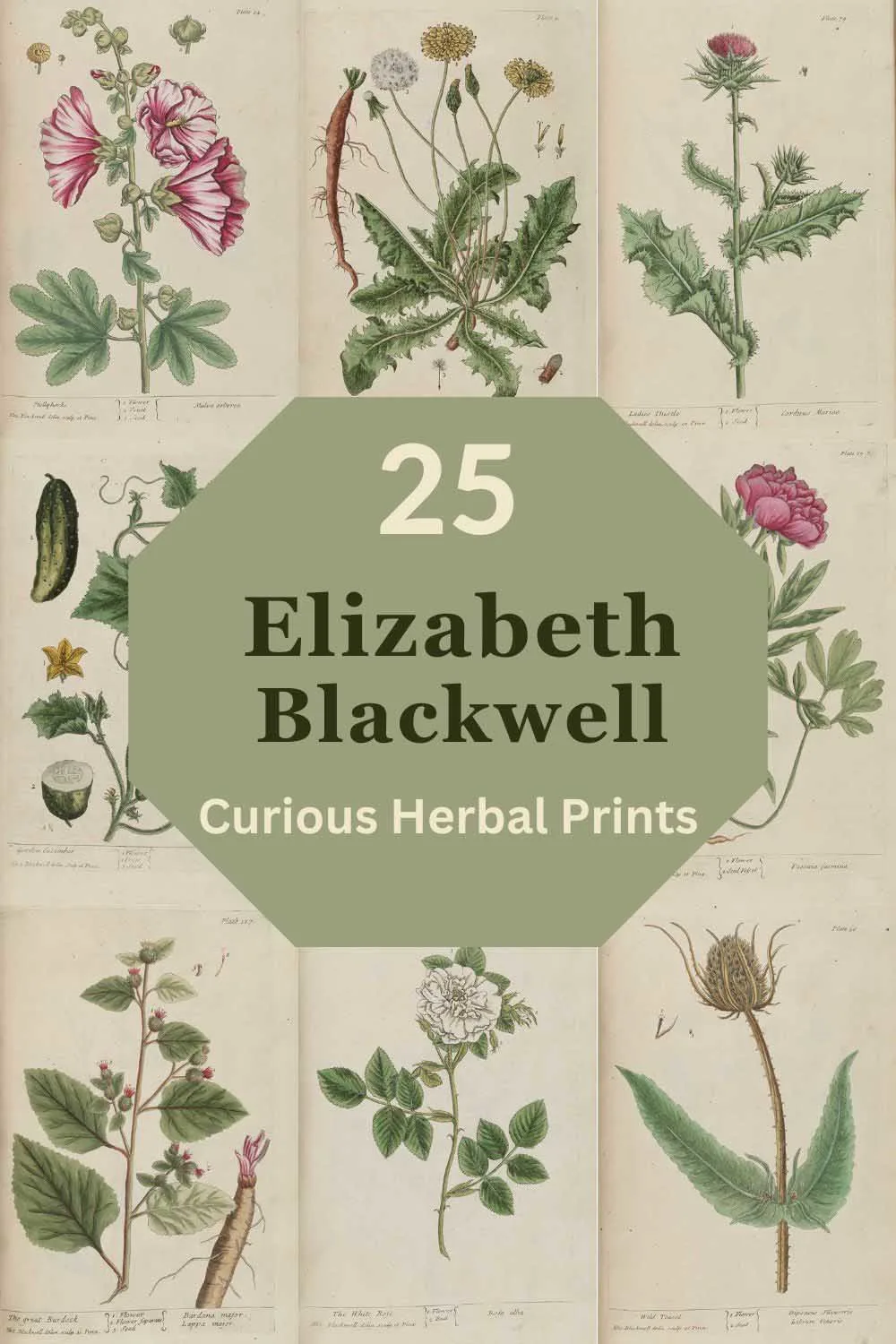
How To Download Blackwell’s Herbal Illustrations
Elizabeth’s masterpiece of botanical art contained over 500 exquisite hand-colored engravings, but I can only showcase a snapshot of them with these 25 prints.
Just click on the title above the herbal print you want and a higher resolution image will open in a new tab. You can then print or save the vintage herbal illustration.
These beautiful prints will be a treat for lovers of botanical art, especially herbal enthusiasts.
The full title of Blackwell’s book is A Curious Herbal. Containing five hundred cuts of the most useful plants, which are now used in the practice of Physick engraved on folio copper plates, after drawings taken from the life / of Elizabeth Blackwell. To which is added a short description of ye plants and their common uses in physick. By Blackwell, Elizabeth, and John Nourse.; Samuel Harding. 1737.
Vintage Herbal Prints 1-6
Blackwell’s illustration and text actively emphasize the medicinal properties of the dandelion, highlighting its use as a remedy for liver and digestive ailments.
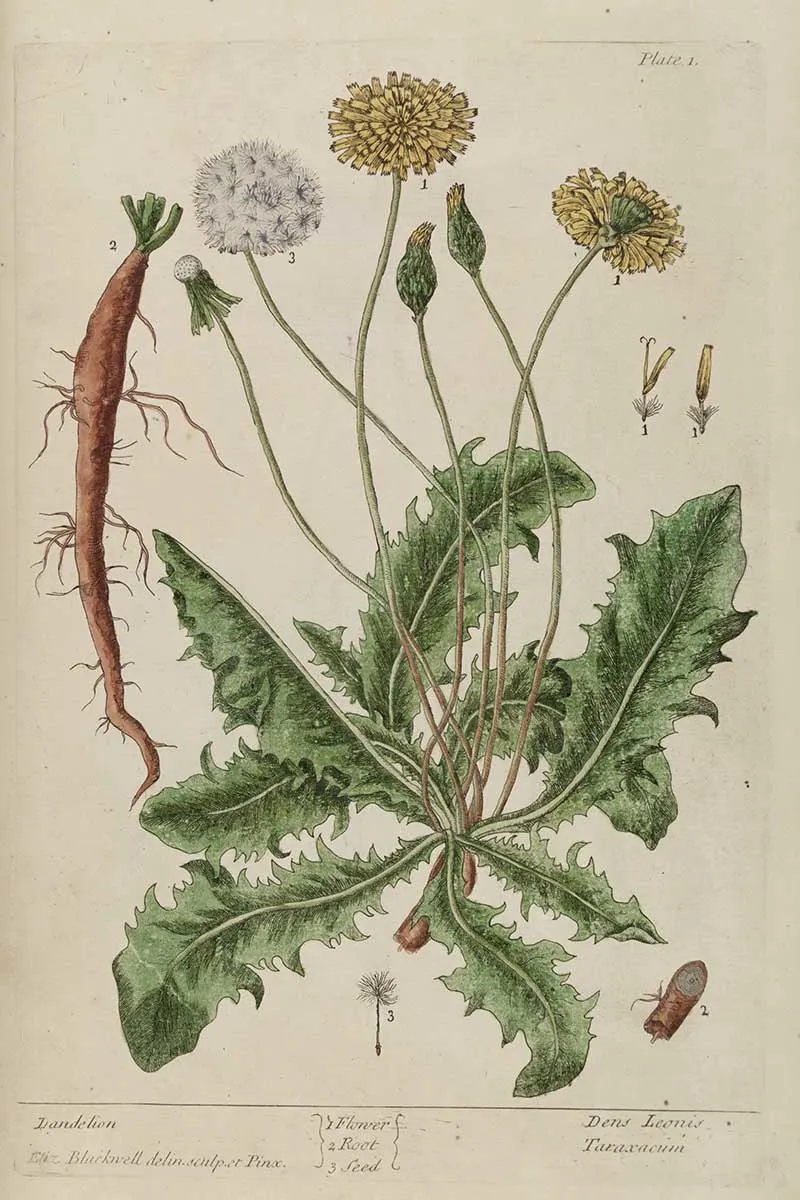
Blackwell’s depiction emphasizes the wild corn poppy’s beauty and role in traditional herbal medicine. She highlights its use for calming and sleep-inducing properties.
Here you’ll find more vintage poppy illustrations.
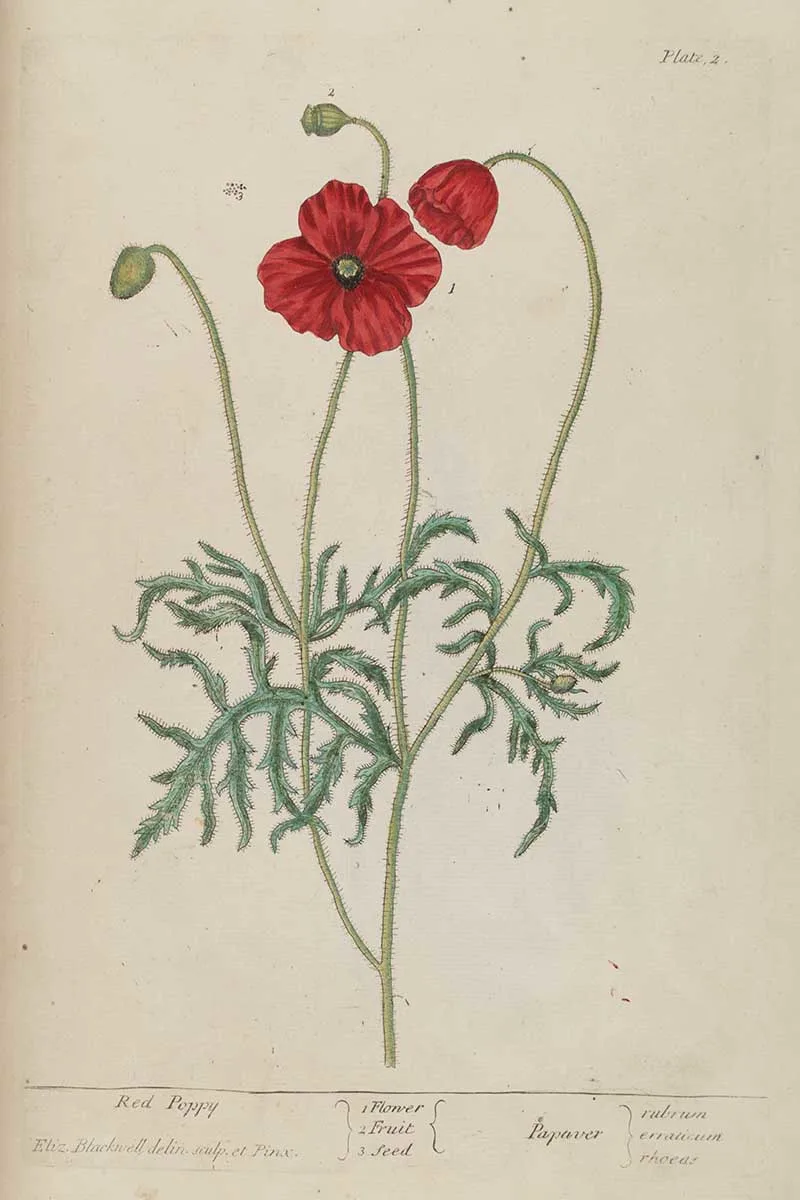
The illustration captures the cucumber’s distinct features, from its elongated green fruit to the trailing vines and leaves. At the same time, the accompanying text delves into its various uses in herbal remedies and culinary applications, showcasing its versatility in the garden and kitchen.
Here are some more vintage vegetable prints.
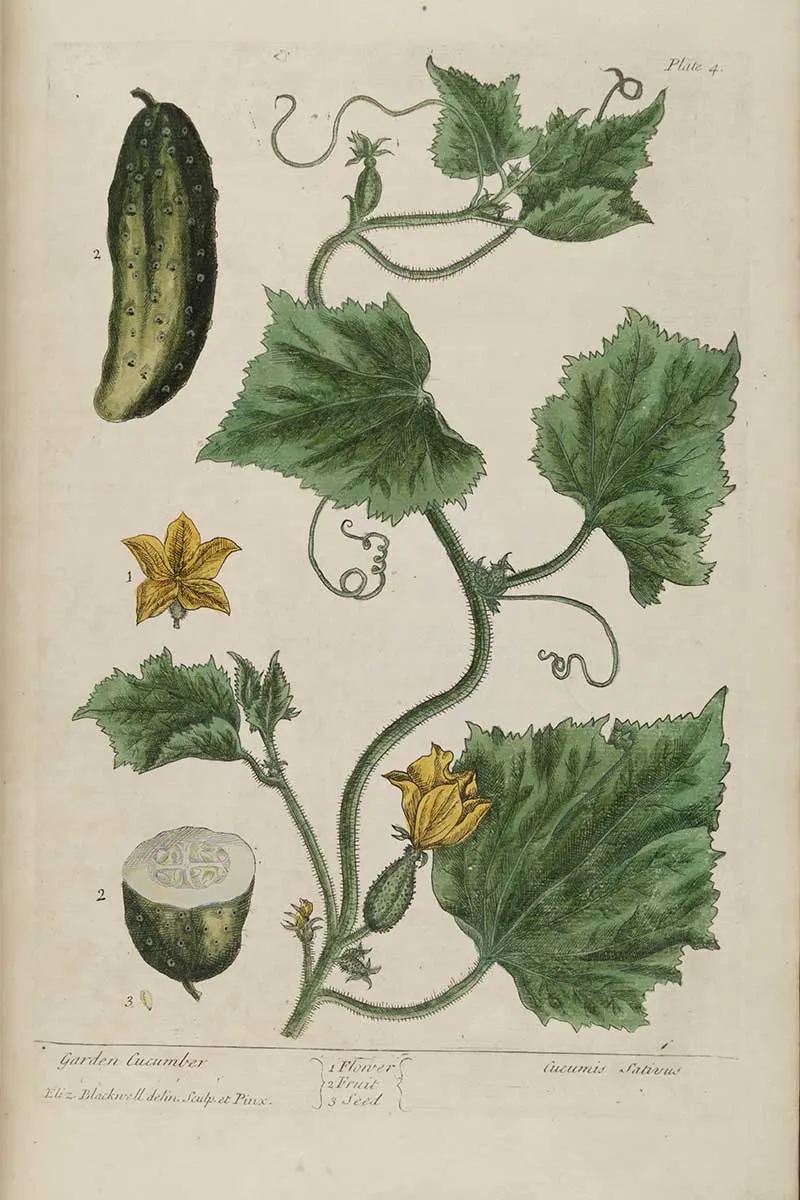
The illustration intricately depicts wood sage’s characteristic features, such as its wrinkled leaves and hooded flowers.
The accompanying text explores its traditional use in herbal medicine, particularly for its astringent properties and potential benefits in treating ailments like diarrhea and throat infections.
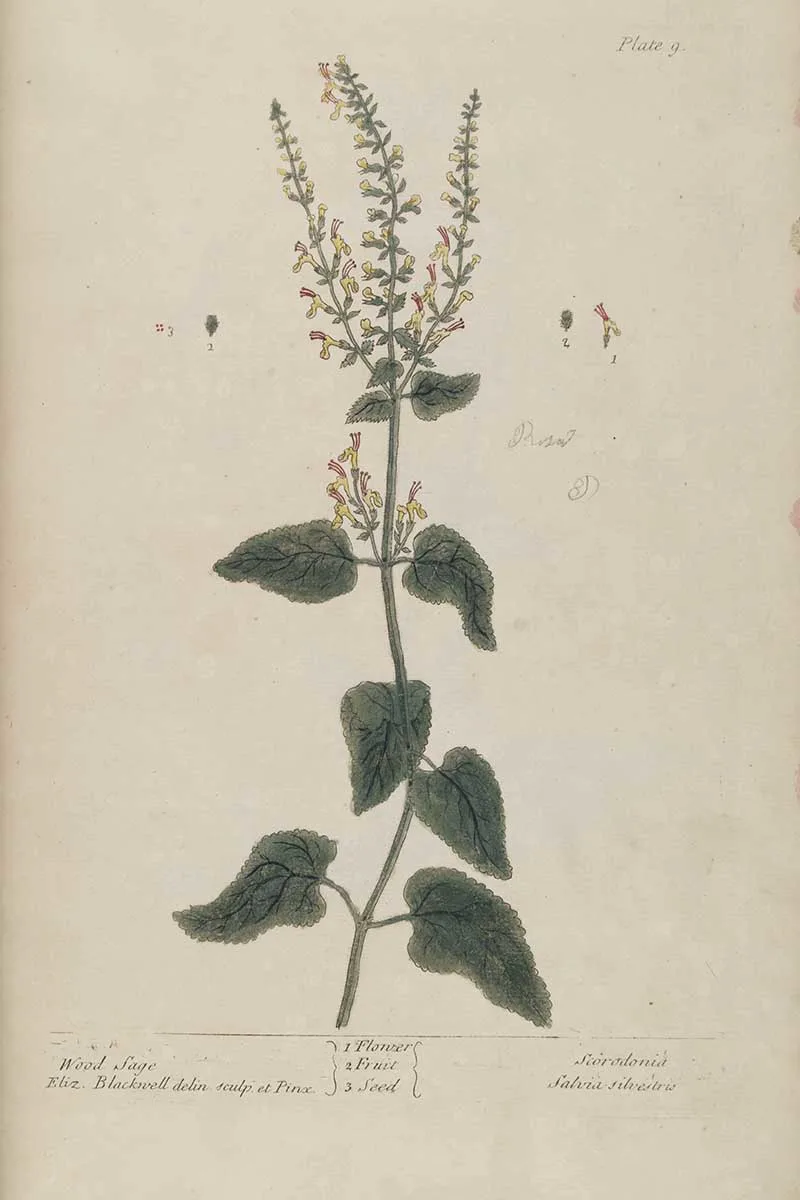
Elizabeth Blackwell’s depiction of the white lily is both elegant and detailed, highlighting the flower’s pure white petals and prominent stamens. Her illustration and description focus on the plant’s traditional medicinal uses, particularly its role in soothing inflammations and burns.
Here you’ll find more vintage lily prints.
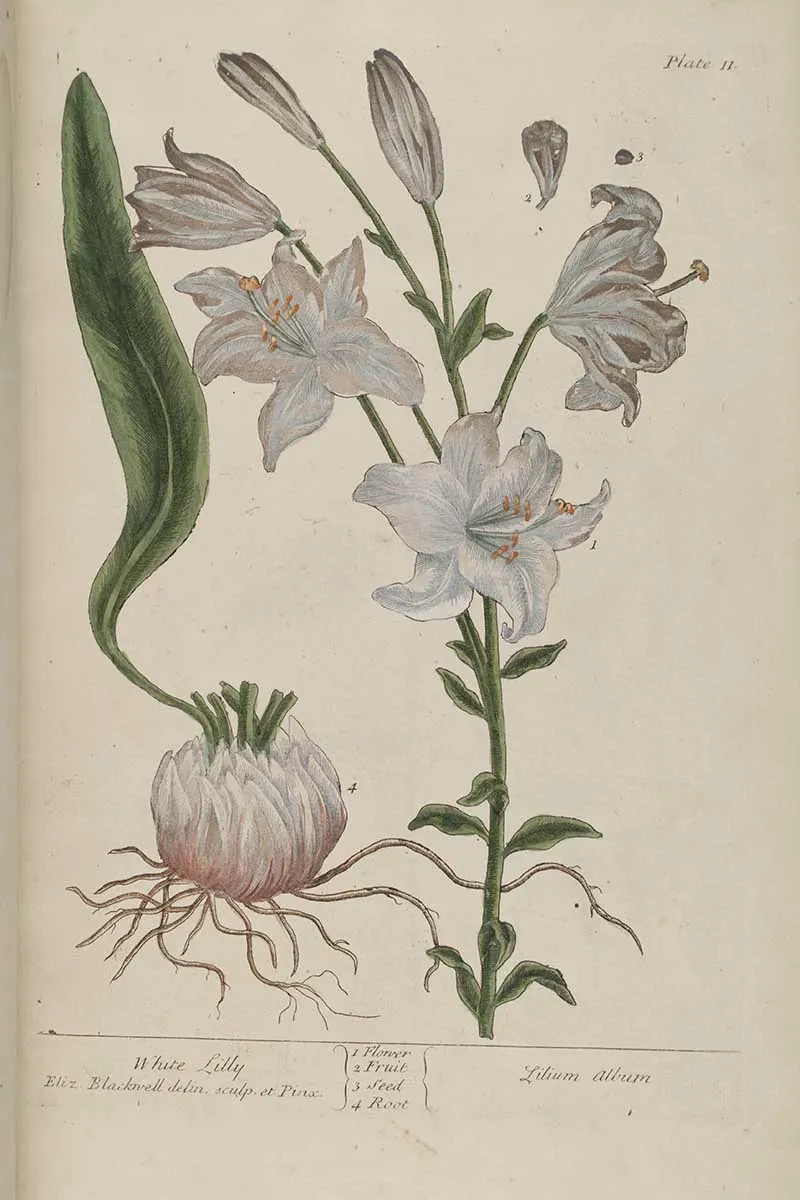
An Elizabeth Blackwell herbal illustration of St. John’s Wort, capturing its bright yellow flowers and distinctive leaf pattern. The accompanying text highlights its use in traditional medicine, particularly for its healing properties in treating wounds and mental health conditions like depression.
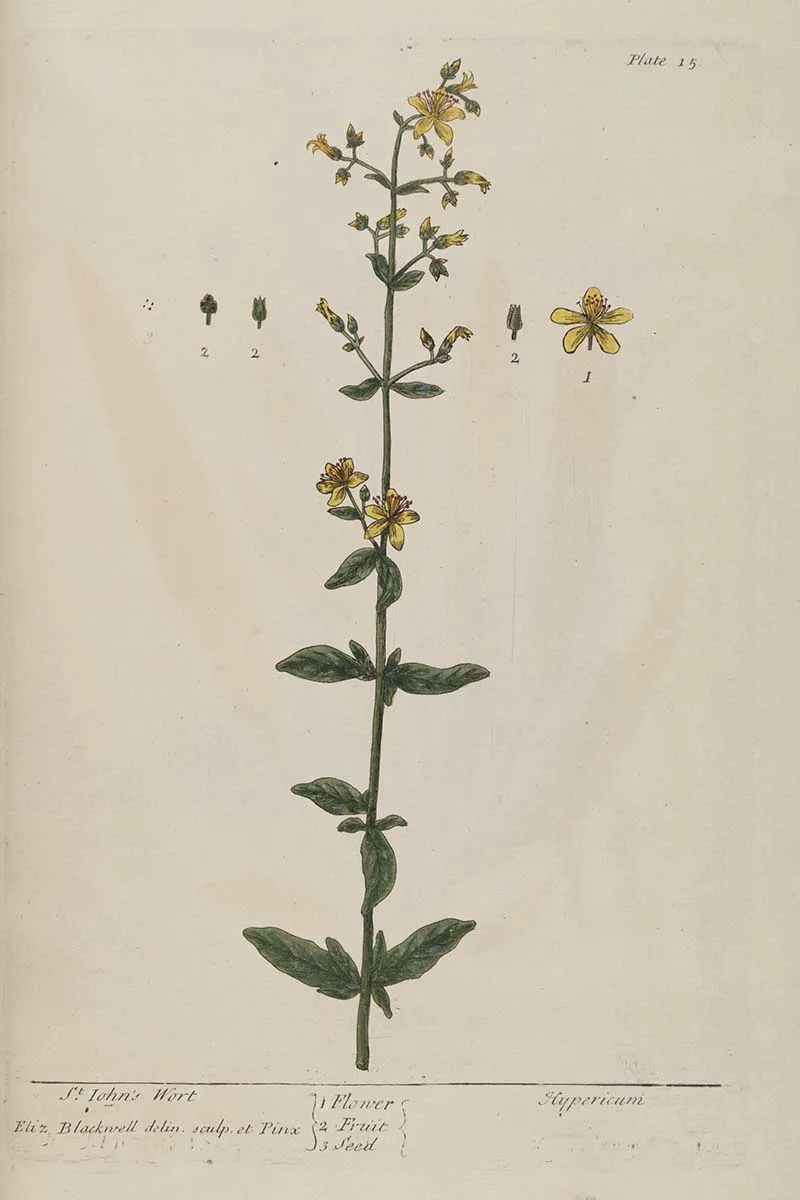
Vintage Herbal Prints 7 to 13
Elizabeth Blackwell’s rendition of the foxglove in “A Curious Herbal” is both striking and informative, showcasing the tall, bell-shaped flowers of this medicinal plant.
Blackwell delves into the foxglove’s use in treating heart conditions, a pioneering insight that foreshadowed its modern medical application in heart medications.
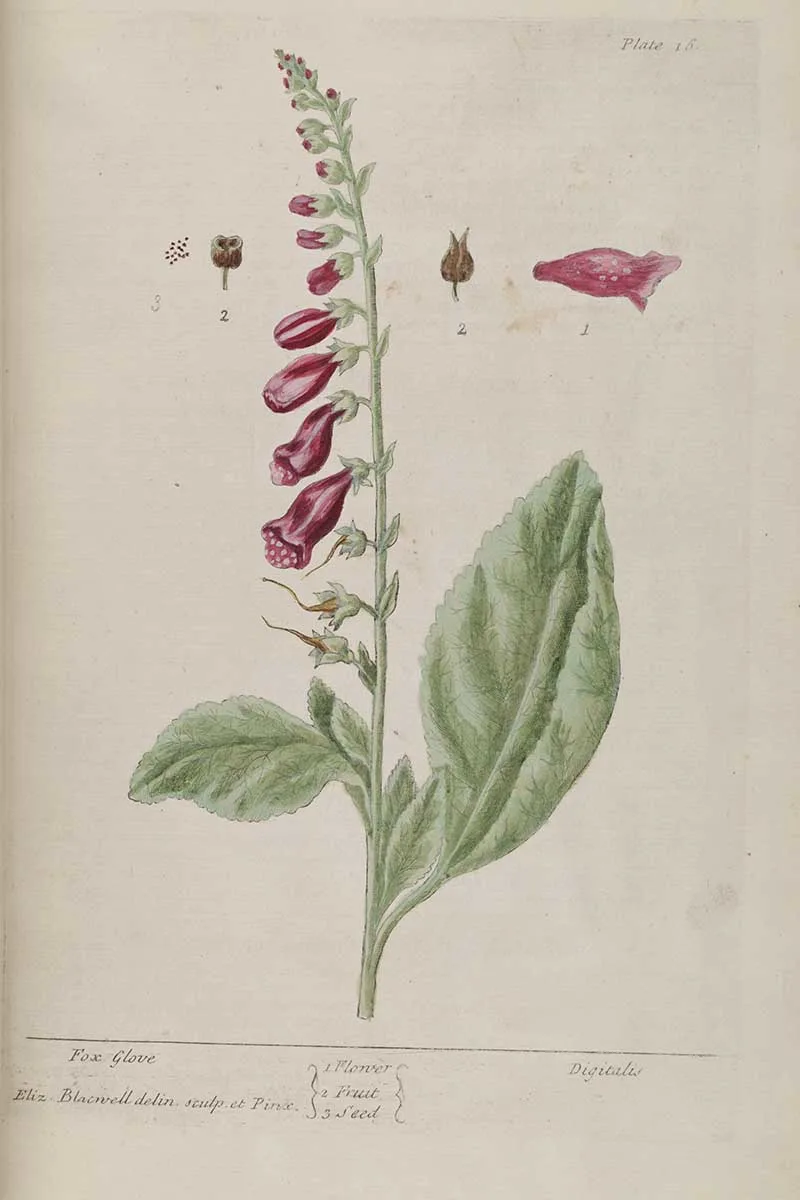
Elizabeth Blackwell’s botanical illustration of the honeysuckle, with its twining vines and trumpet-shaped flowers, vividly captures the plant’s charming aesthetic.
Her detailed notes discuss the honeysuckle’s use in traditional remedies, highlighting its effectiveness in treating respiratory conditions and its soothing, anti-inflammatory properties.
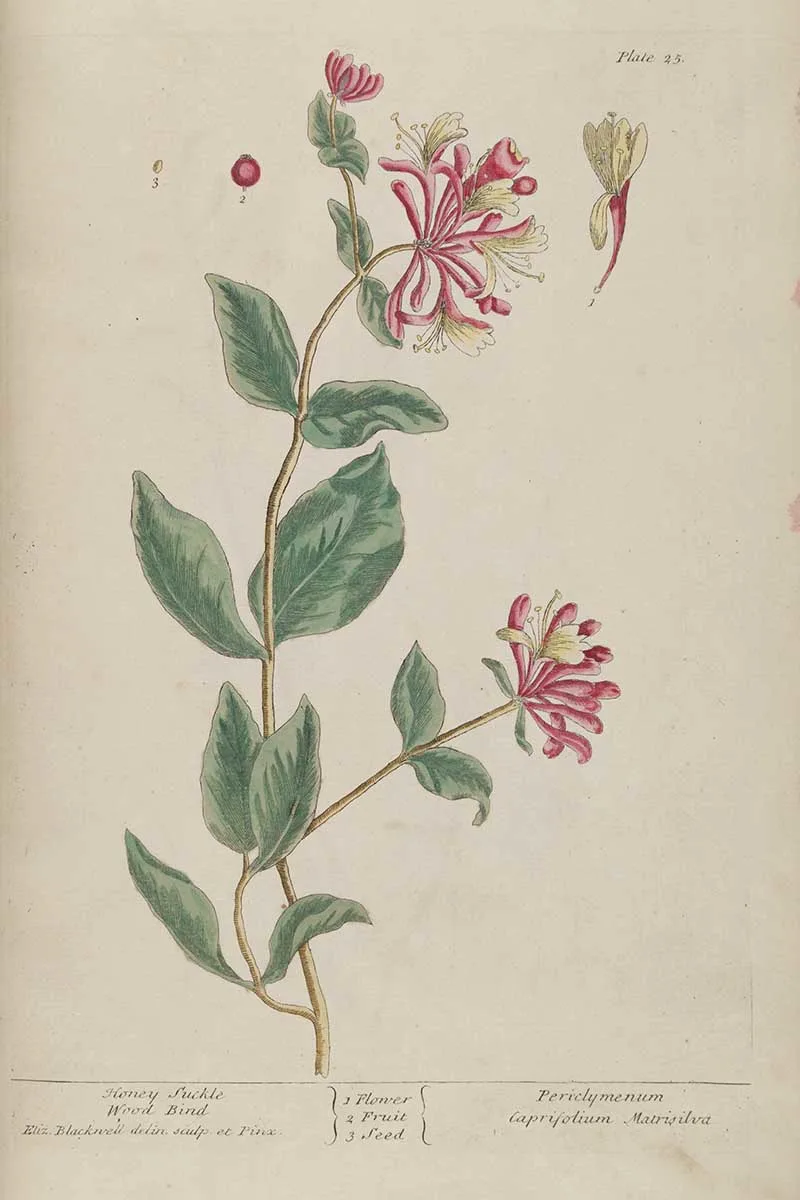
Blackwell’s focuses on the plant’s effectiveness in digestive aid and its soothing qualities for stomach issues.
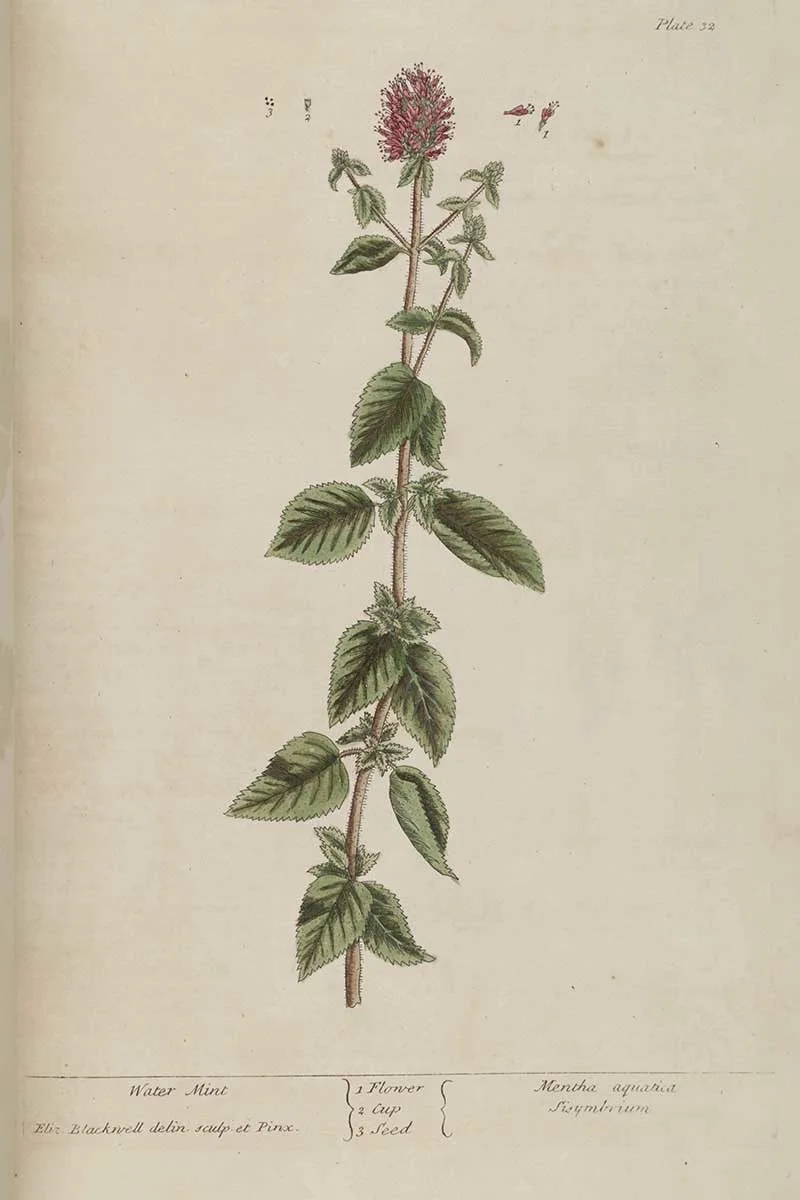
Print 10: White Archangel Dead Nettle
Elizabeth Blackwell’s botanical print captures the delicate details of this plant, from its whorled leaves to the intricate white flowers. Her notes discuss the white archangel’s applications in treating wounds and its anti-inflammatory properties.
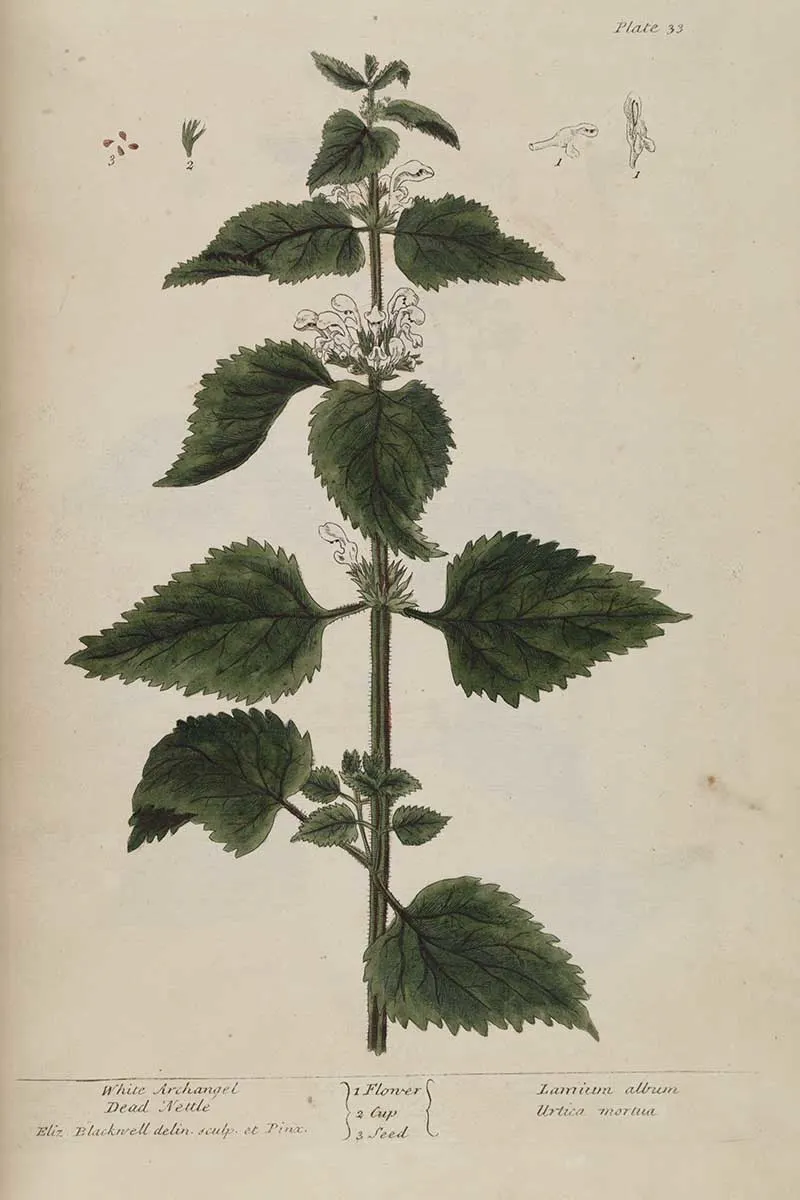
Elizabeth Blackwell illustrates the great bindweed, showing its big, trumpet-like flowers and twining vines. Her notes mention its use in old remedies, mainly for its laxative effects.
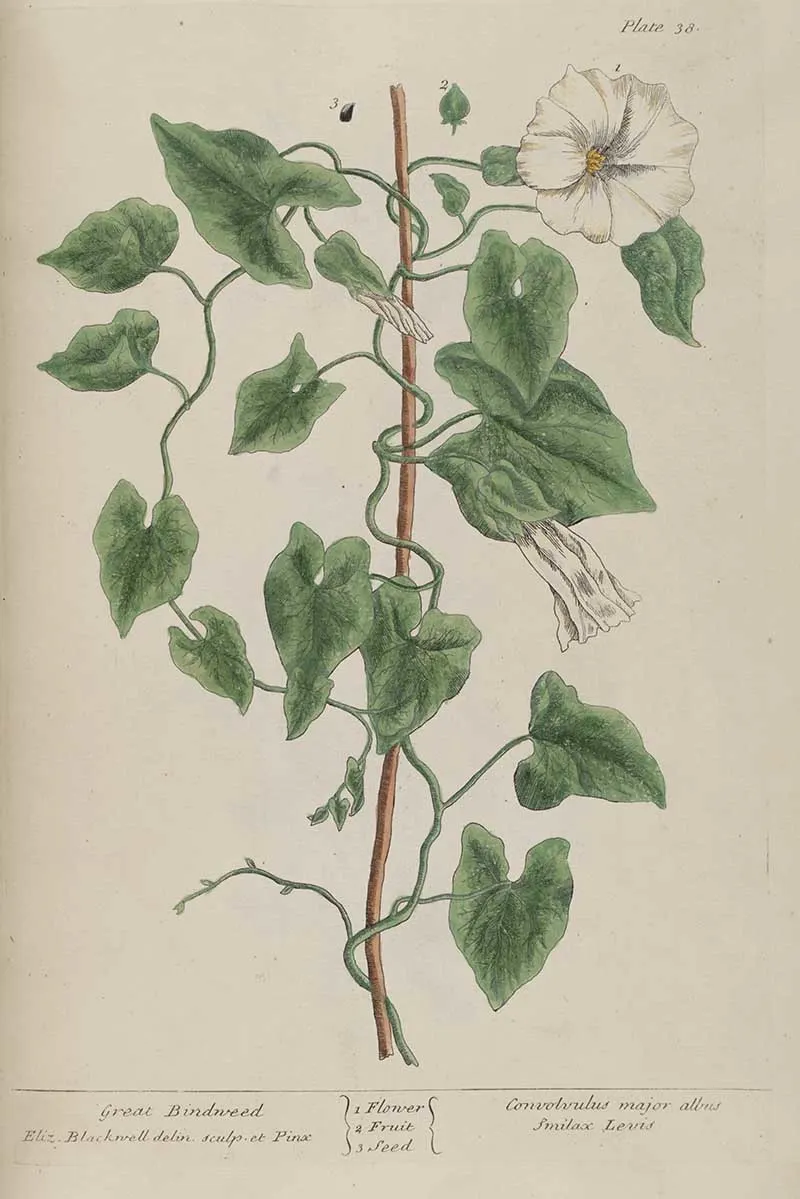
The Ox-eye Daisy, is a perennial wildflower recognizable by its bright white petals radiating around a yellow disc center. This widespread flower is used in traditional herbal medicine, particularly for its mild astringent and soothing properties.
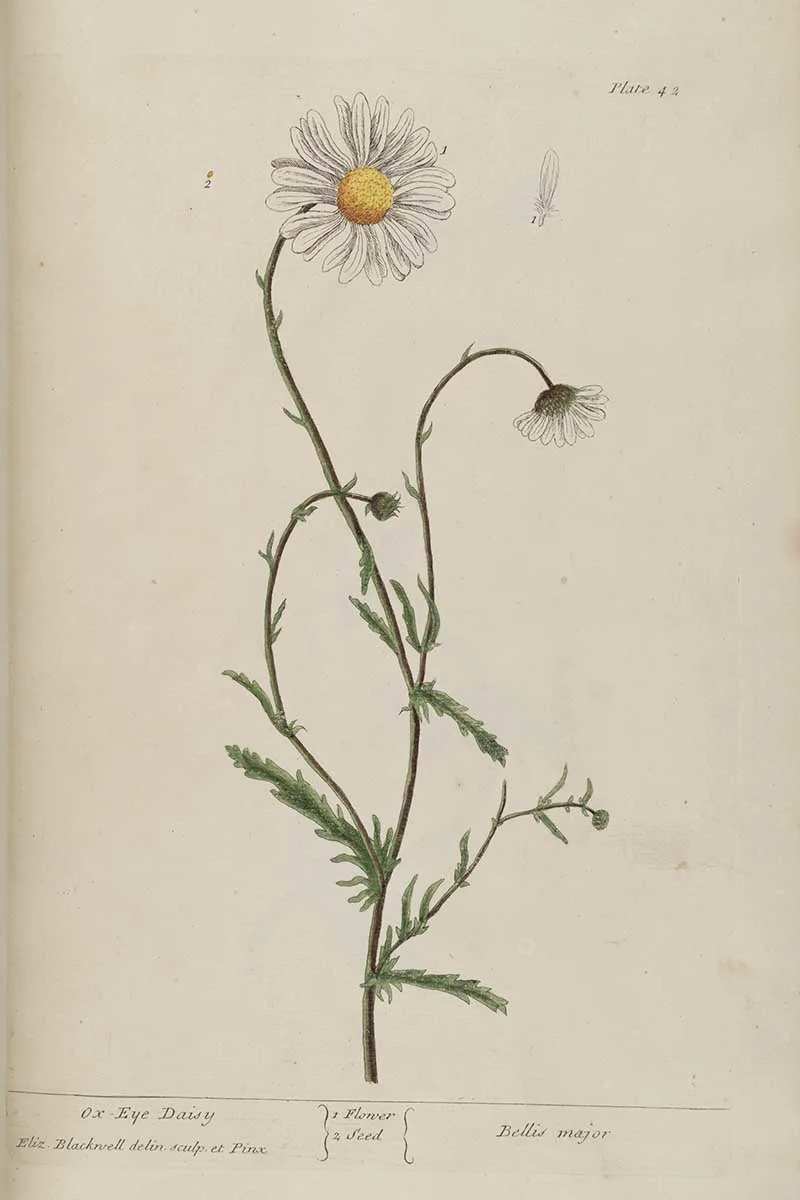
The pimpernel, is a small yet vibrant wildflower, often recognized for its bright red, orange, or blue blossoms. Valued for its potential diuretic and wound-healing properties.
It also has a rich folklore associated with its color-changing blooms that were believed to predict weather changes.
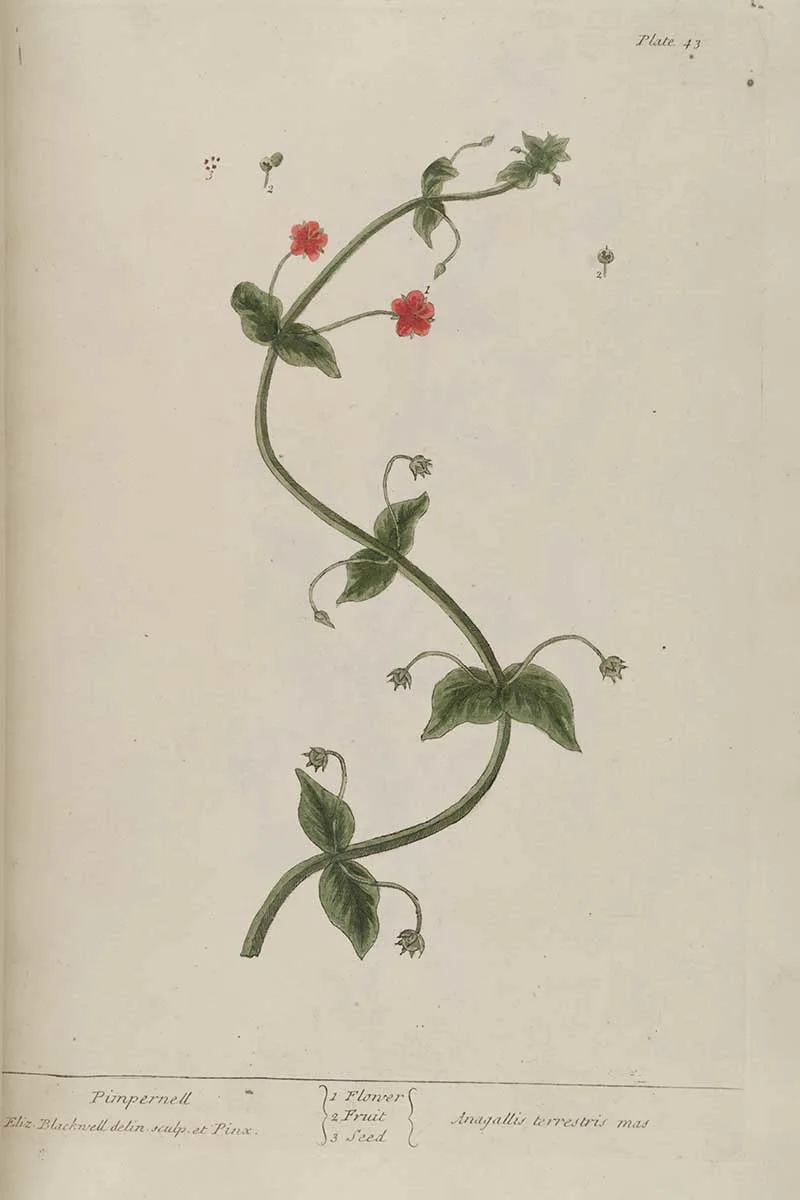
Vintage Herbal Botanicals 14-19
The wild teasel is a striking plant with tall stems and distinctively cone-shaped, spiky flower heads. Historically utilized in textile processing, this plant was also used for its reputed diuretic and liver-stimulating properties.
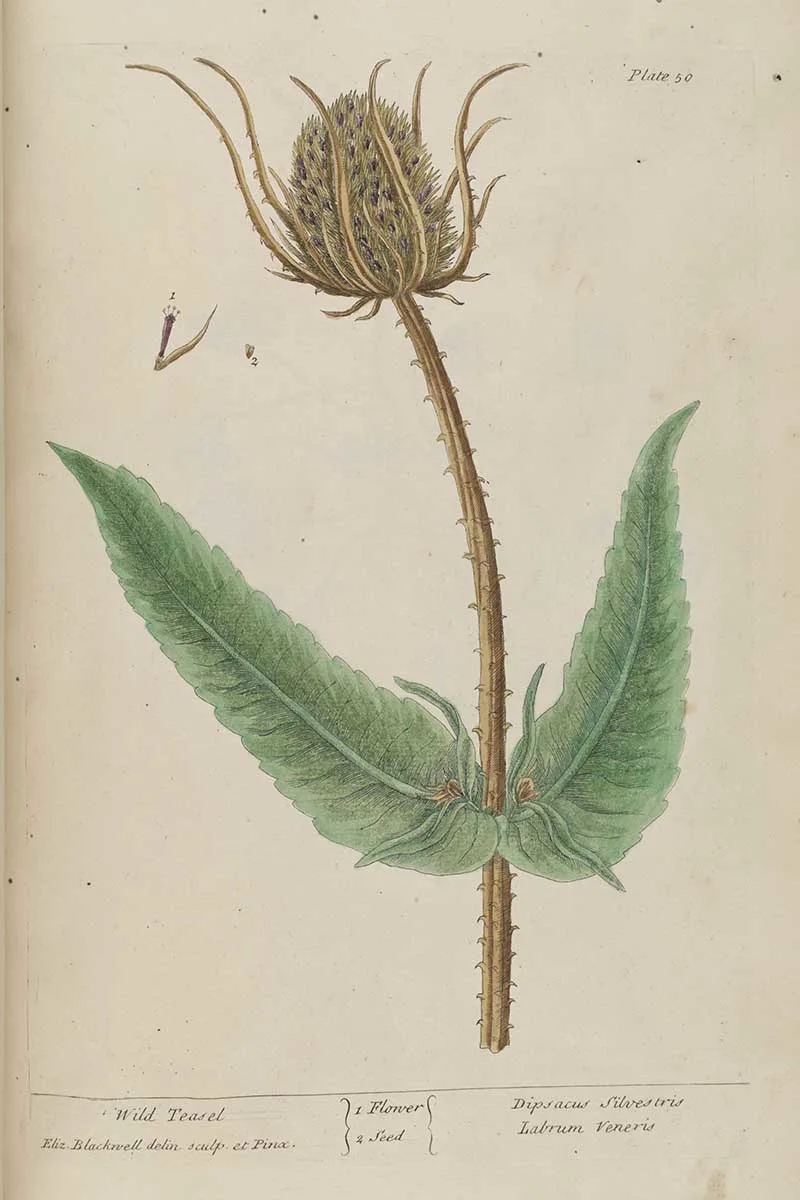
Hollyhocks, with their tall spikes of large, colorful flowers, are a charming addition to any garden. Hollyhocks are known for their soothing properties, particularly in treating respiratory and inflammatory conditions.
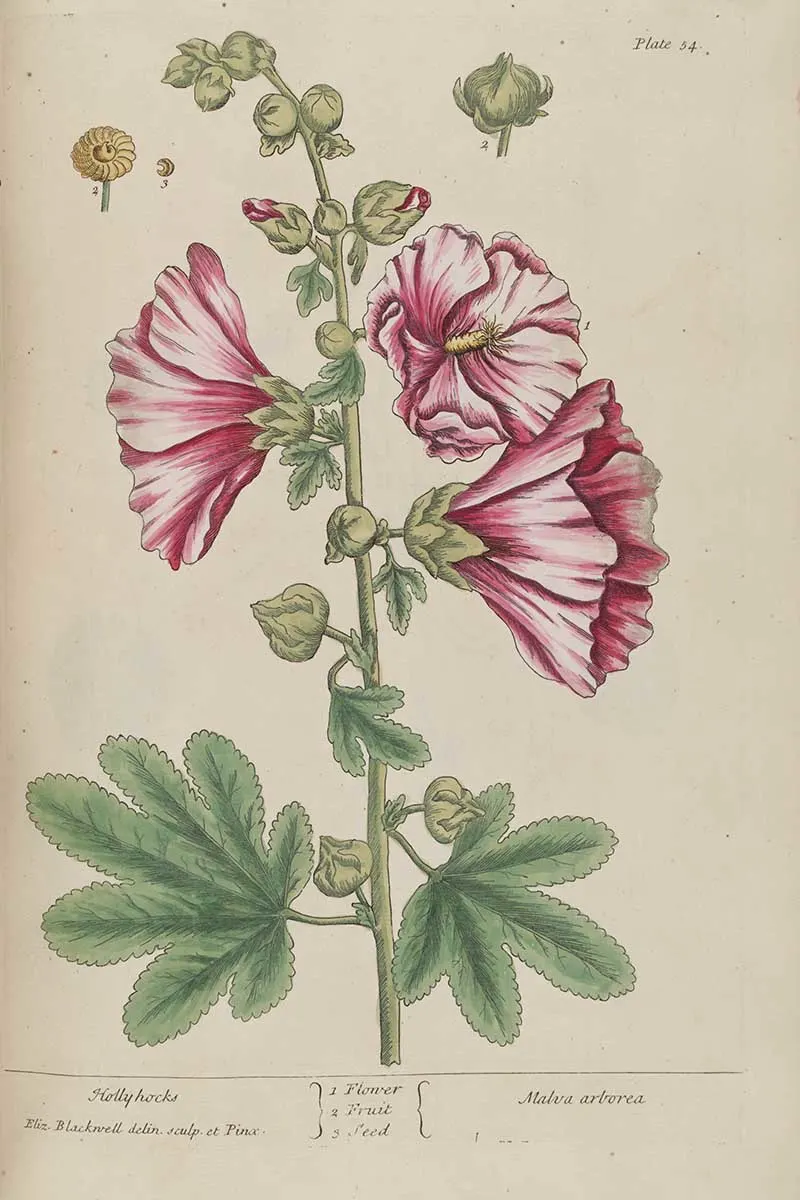
The female peony, often referred to in botanical terms as Paeonia officinalis, has a long history in traditional herbal medicine. It is particularly valued for its purported anti-inflammatory properties and use in treating various ailments, from menstrual cramps to nervous system disorders.
Check out these other peony illustrations.
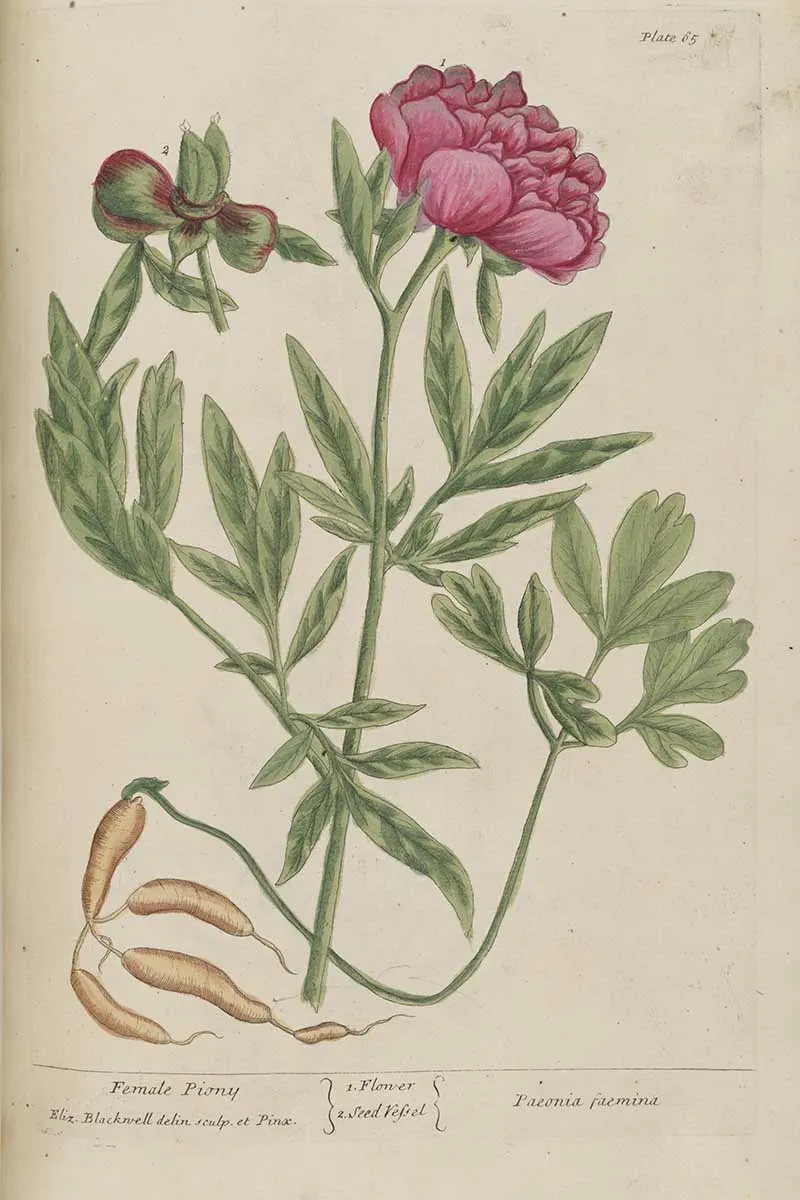
Faetid camomile, also known as stinking chamomile, is a plant with a distinctive, strong odor and daisy-like flowers. Despite its pungent smell, this herb has been used for its soothing and anti-inflammatory properties.
It has been applied in treating skin irritations, digestive issues, and as a mild sedative. Illustrating the adage that not all beneficial plants are necessarily pleasant to the senses.
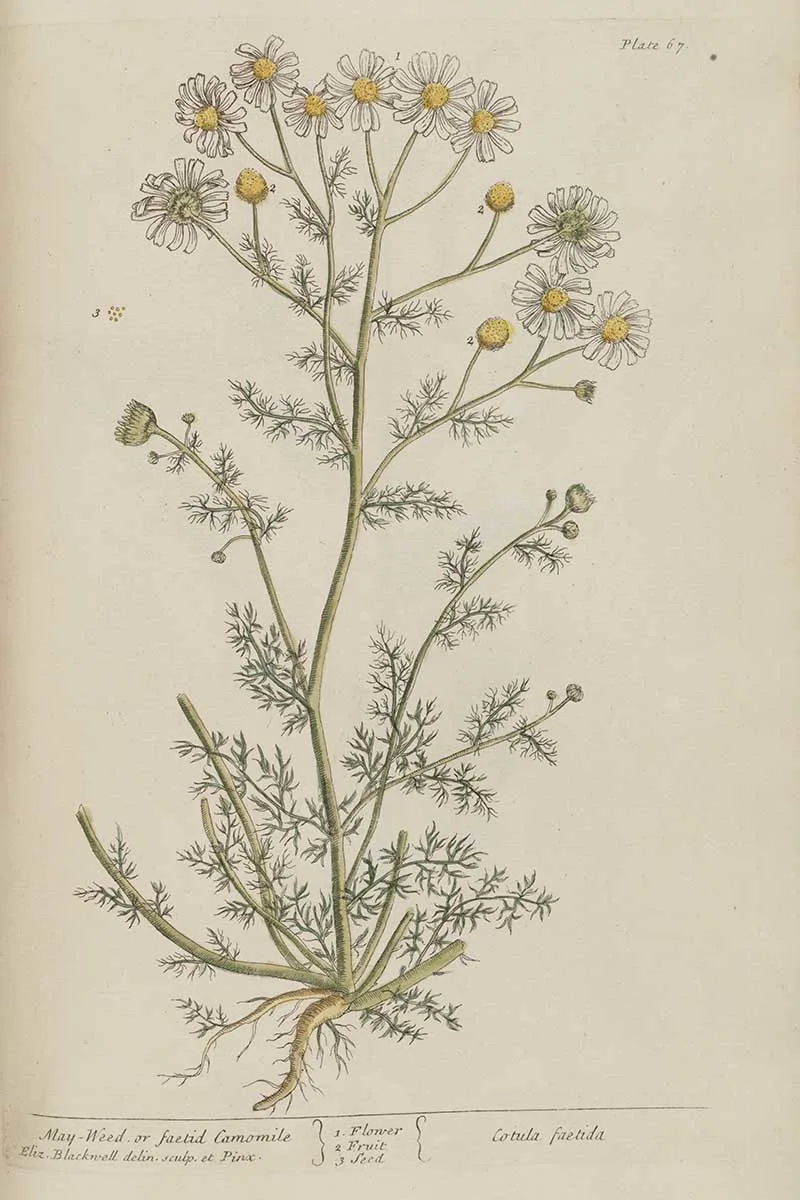
Print 18: Garden Fleur-De-Luce
The Garden Fleur De Luce, or Iris germanica, is renowned for its vibrant, uniquely shaped flowers. This plant has uses for its fragrant rhizomes used in treating skin and respiratory issues.
Check out these beautiful Japanese Iris paintings.
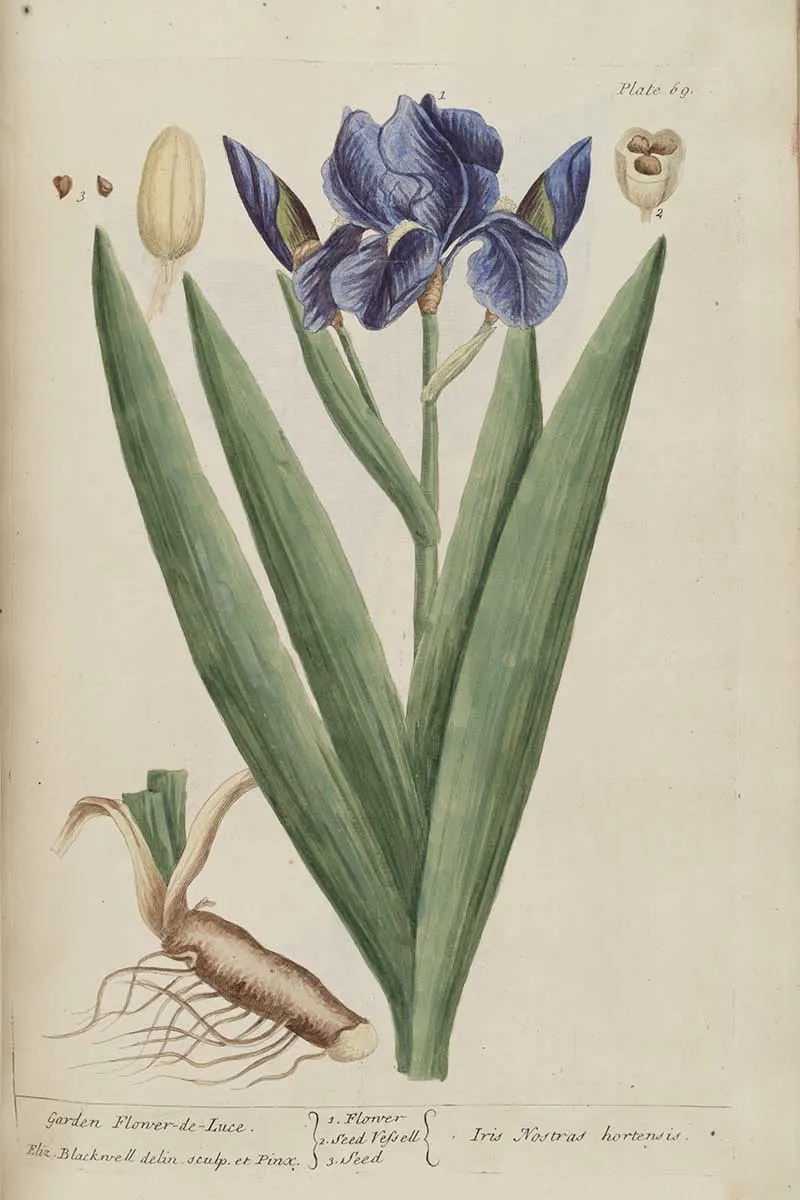
In “A Curious Herbal,” Elizabeth Blackwell details the white rose’s soothing properties and its application in skin and eye treatments.
Here are some more botanical rose illustrations.
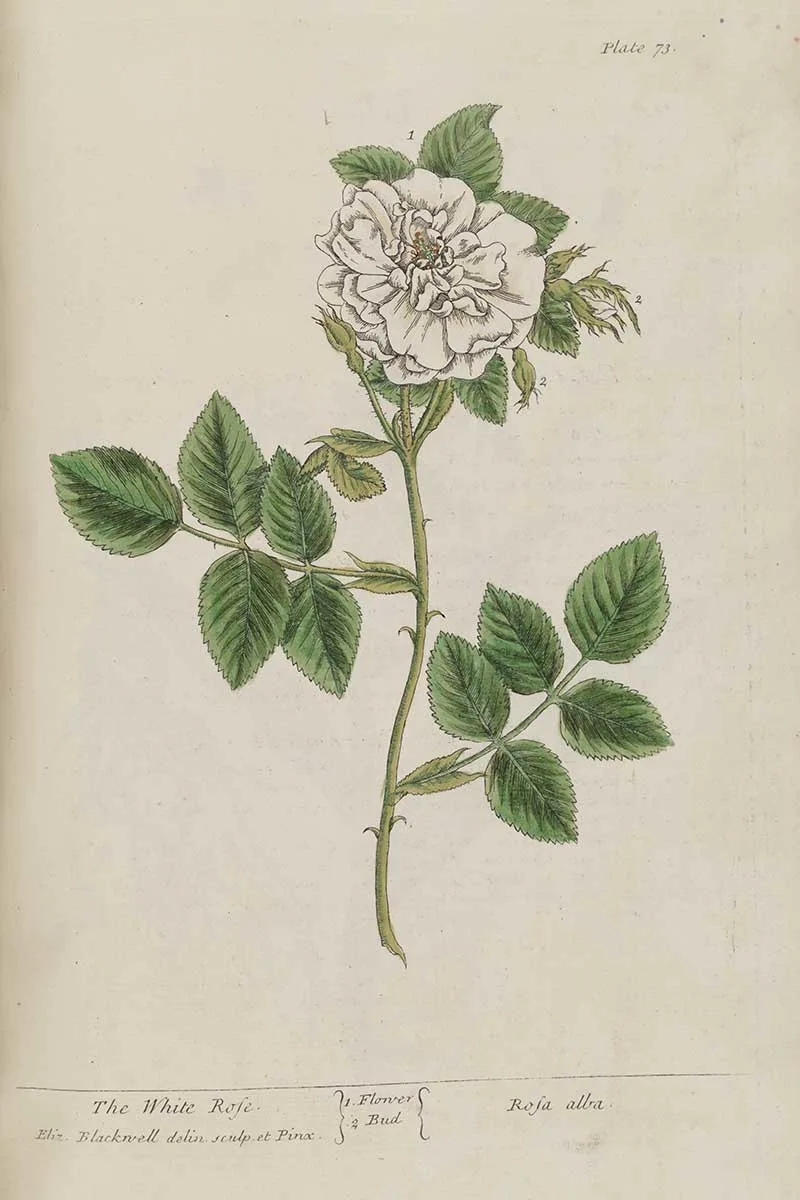
Vintage Herbal Prints 20-25
Elizabeth Blackwell’s notes focuses on the roses effectiveness for skin care and its inclusion in aromatic treatments.
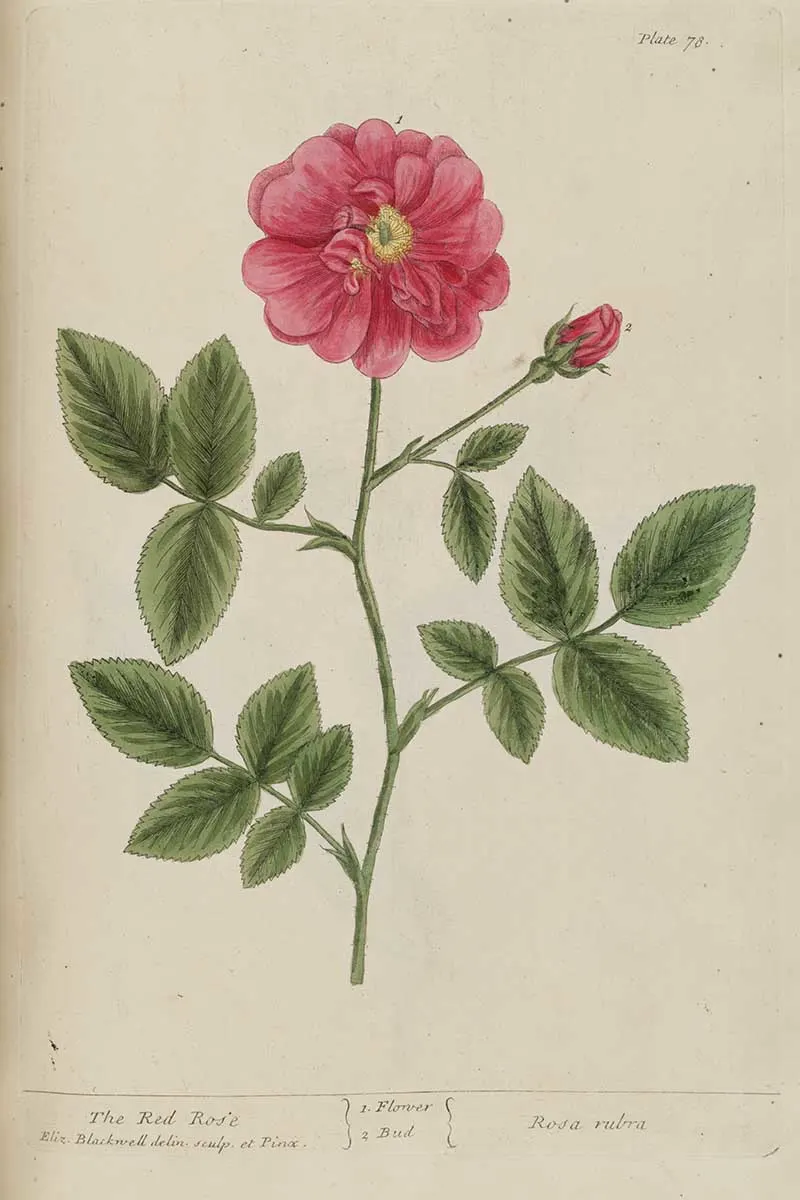
The Lady’s Thistle, or Milk Thistle, is a plant known for its distinctive appearance. With glossy, variegated leaves with white veins and vibrant purple to pink thistle-like flowers.
It has been valued for its liver-protecting properties. The active compound silymarin is extracted from the seeds. And it’s still studied and used today for the potential benefits in liver health and other therapeutic applications.
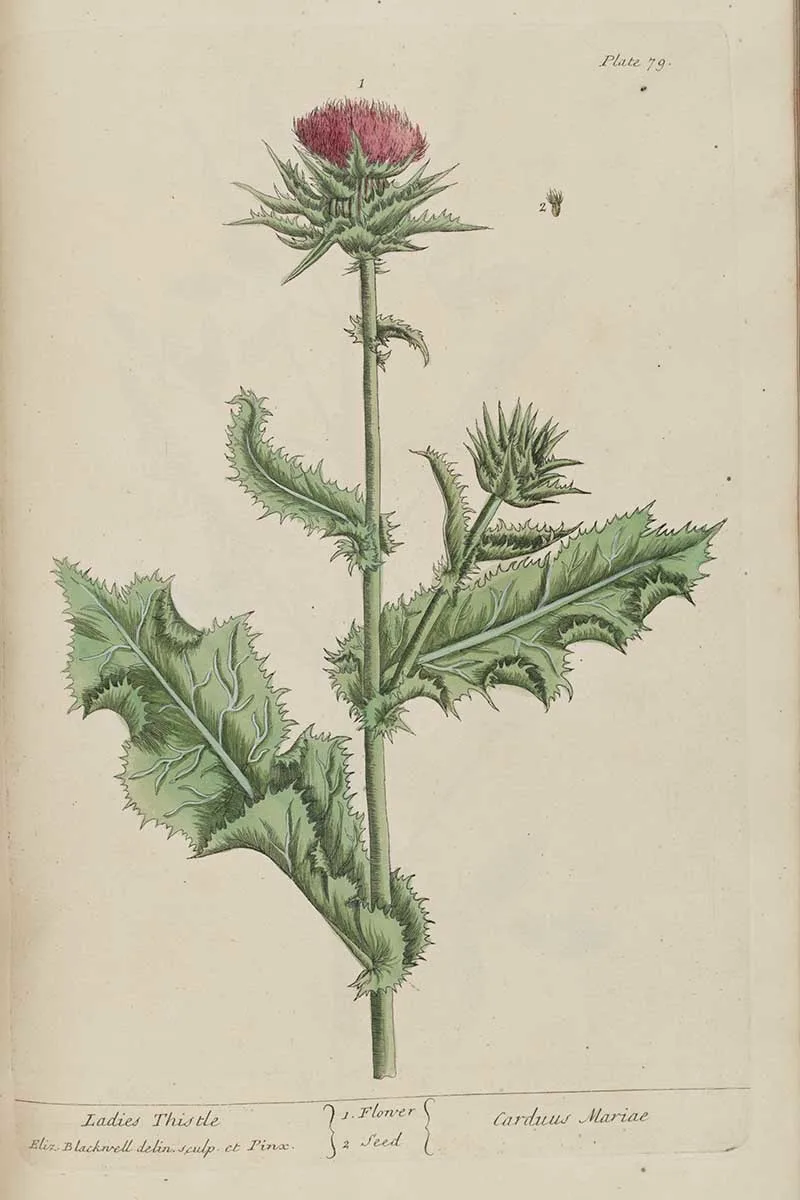
The Clove July Flower, or Dianthus, exudes a spicy clove-like scent and displays bright colours with fringed petals. Blooming in July, it gains popularity for its beauty and serves in traditional remedies for minor wounds.
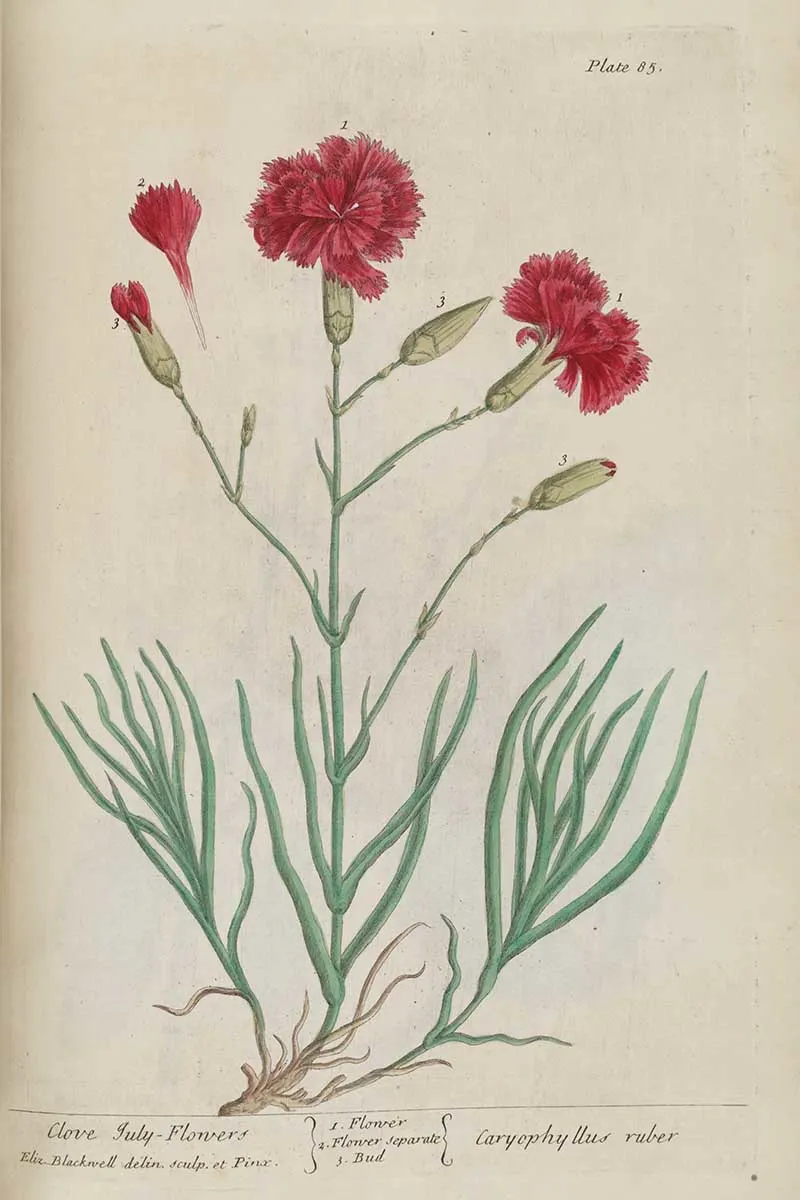
The Bear’s Breech, is a striking plant with large, glossy leaves and tall spikes of white or purplish flowers. The leaves were believed to have soothing qualities when applied topically.
Garden designers often use this architectural plant, Bear’s Breech, for its dramatic foliage and flowers. It has gained recognition for its symbolic significance in art and architecture, with its leaf pattern famously replicated in Corinthian column capitals in ancient Greek and Roman decor.
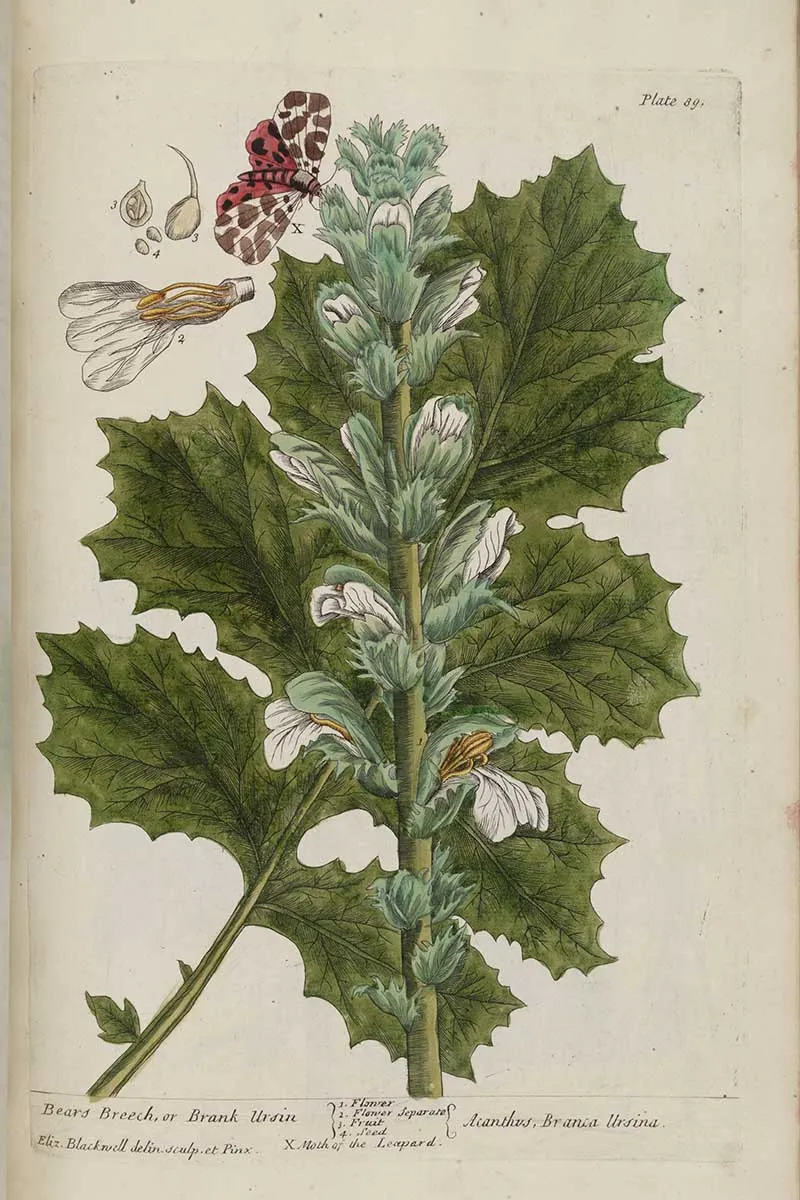
Marigolds, with their bright orange and yellow flowers, serve dual roles as both garden plants and herbal medicine components.
People traditionally use them for their skin healing properties and in teas to enhance digestive health. Additionally, they function as natural plant dyes and add visual appeal to salads.
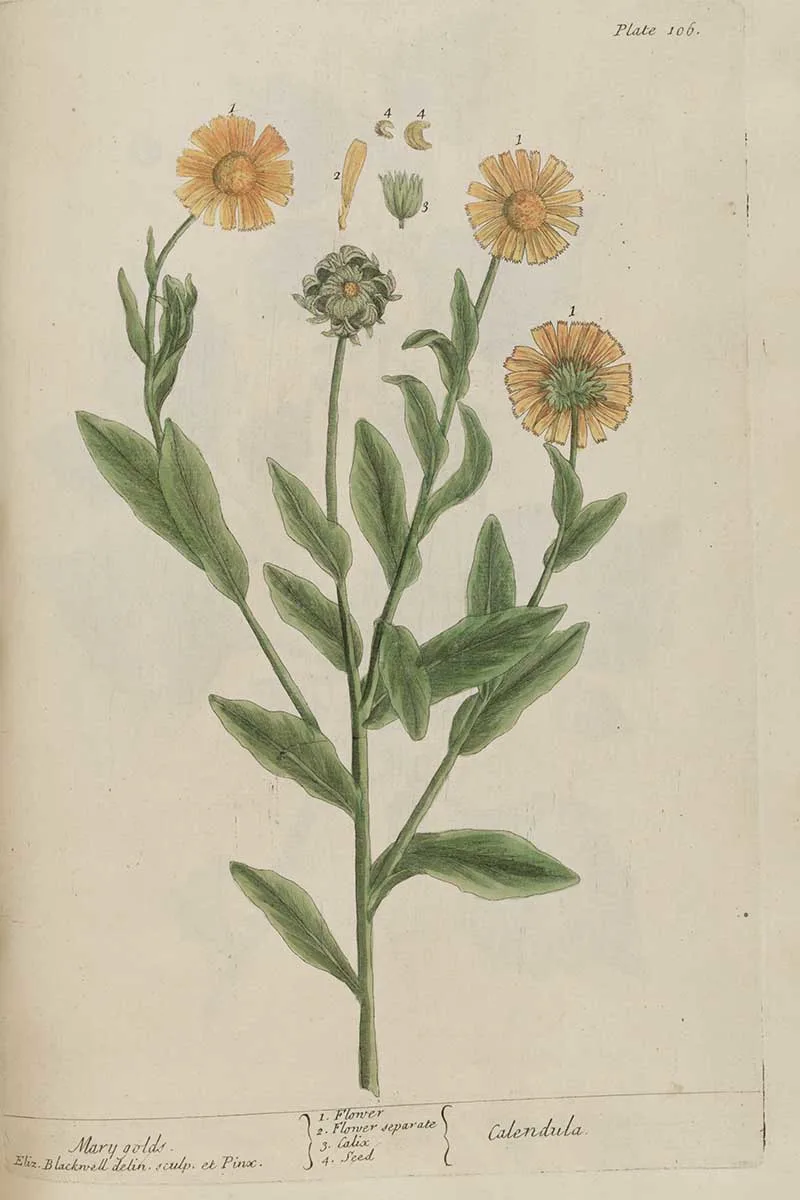
The Great Burdock is recognized for its large, heart-shaped leaves and prickly burr-like seed heads.
The are roots used in treating skin conditions, promoting healthy hair and scalp, and supporting liver function. Its diuretic and blood-purifying qualities make it a common ingredient in traditional herbal remedies for a range of health issues.
As I child I remember drinking dandelion and burdock soda as treat.
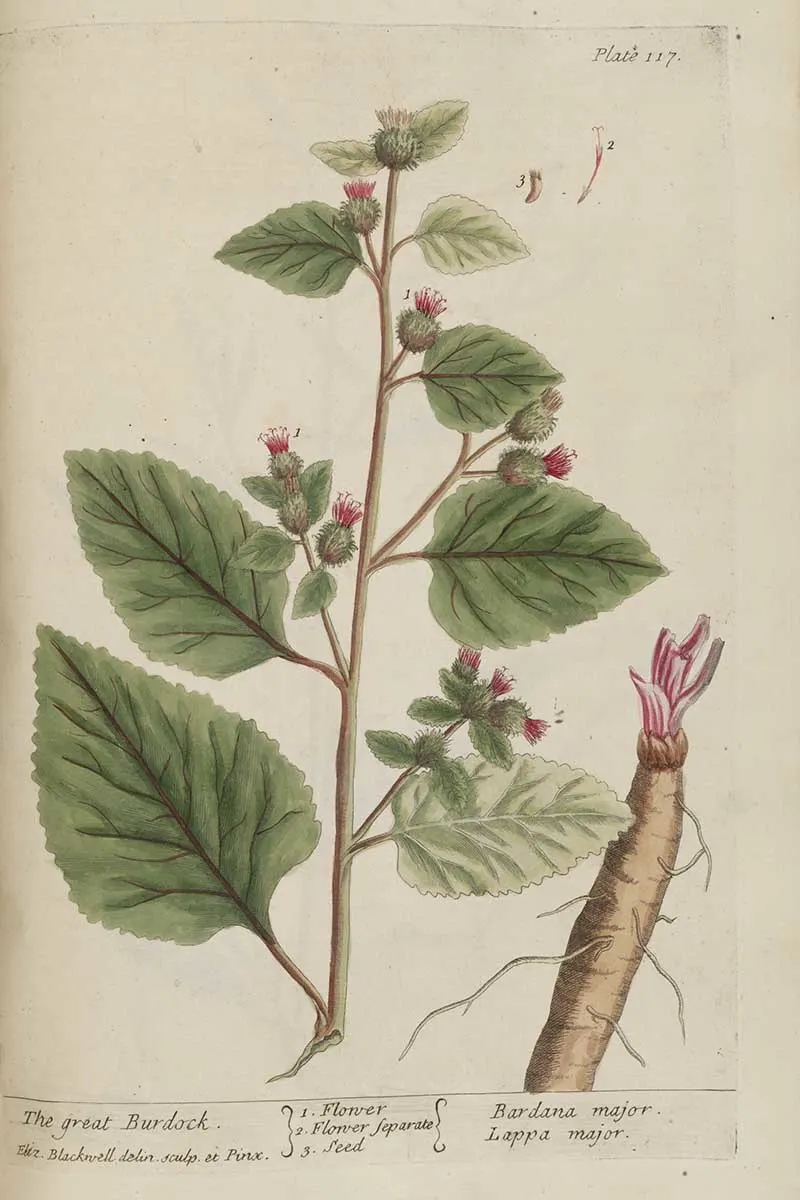
Other Vintage Botanical Prints
In summary, “A Curious Herbal” by Elizabeth Blackwell beautifully merges art with herbal knowledge. Each illustration, from the vibrant flowers to the medicinal herbs, offers a glimpse into 18th-century botanical and medicinal practices. This collection is more than just art; it’s a bridge connecting us to the historical uses of plants and the enduring importance of nature in our lives.
Don’t forget to check out the huge collection of vintage botanical prints on the site.
If you liked these prints then I recommend that you check out some of these other beautiful plant collections on the site.
These include the artistic wild flower illustrations of Harriet Adams, Jane Loudon’s beautiful bulbs and Johannes Gessner’s photographic botany prints.
If you fancy, you can Buy Me A Coffee Here.

Becky ~ The Vixens Den
Tuesday 6th of February 2024
These drawings are gorgeous! Thank you so much for sharing their history with us at Whimsy Home Wednesday!